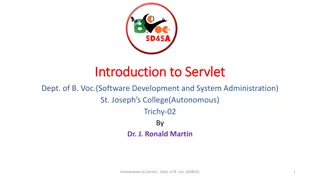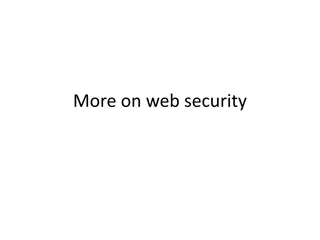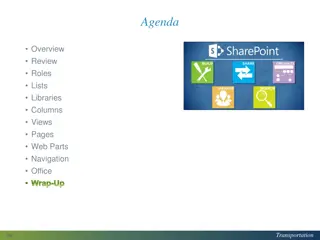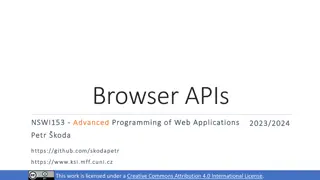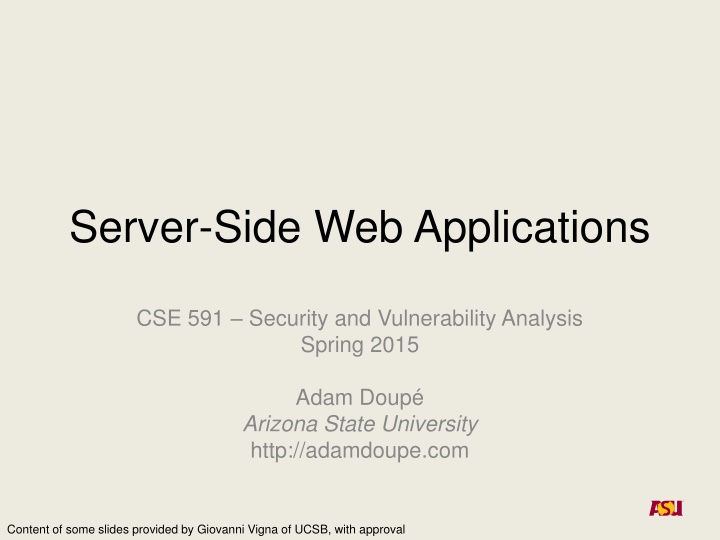
Security and Vulnerability Analysis in Web Applications
"Explore the foundational protocols of the web and the evolution of web applications, focusing on server-side code and maintaining state for user sessions. Understand the significance of HTTP, GET and POST methods, and ways to embed information in URLs for dynamic web responses."
Download Presentation

Please find below an Image/Link to download the presentation.
The content on the website is provided AS IS for your information and personal use only. It may not be sold, licensed, or shared on other websites without obtaining consent from the author. If you encounter any issues during the download, it is possible that the publisher has removed the file from their server.
You are allowed to download the files provided on this website for personal or commercial use, subject to the condition that they are used lawfully. All files are the property of their respective owners.
The content on the website is provided AS IS for your information and personal use only. It may not be sold, licensed, or shared on other websites without obtaining consent from the author.
E N D
Presentation Transcript
Server-Side Web Applications CSE 591 Security and Vulnerability Analysis Spring 2015 Adam Doup Arizona State University http://adamdoupe.com Content of some slides provided by Giovanni Vigna of UCSB, with approval
Overview So far, we've examined the three main protocols underpinning the web URI/URL HTTP HTML What we've studied has been a distributed document retrieval system This is the historical basis for the web Adam Doup , Security and Vulnerability Analysis
Web Applications It was quickly realized that the way the web was structured allowed for returning dynamic responses Early web was intentionally designed this way, to allow organizations to offer access to a database via the web Basis of GET and POST also confirm this GET "SHOULD NOT have the significance of taking an action other than retrieval" Safe and idempotent POST Annotation of existing resources; posting a message to a bulletin board, newsgroup, mailing list, or similar group of articles, providing a block of data, such as the result of submitting a form, to a data-handling process; and extending a database through an append operation Adam Doup , Security and Vulnerability Analysis
Web Applications Server-side code to dynamically create an HTML response How does this differ from a web site? In the HTTP protocol we've looked at so far, each request is distinct Server has client IP address and User-Agent Adam Doup , Security and Vulnerability Analysis
Maintaining State HTTP is a stateless protocol However, to write a web application we would like maintain state and link requests together The goal is to create a "session" so that the web application can link requests to the same user Allows authentication Rich, full applications Three ways this can be achieved Embedding information in URLs Using hidden fields in forms Using cookies Adam Doup , Security and Vulnerability Analysis
Embedding Information in URLs When a user requests a page, the application embeds a unique identifier in every link contained in the HTML page returned to the user First client request: GET /login.php?user=foo&pwd=bar HTTP/1.1 Server HTML reply: <html> <a href="account.php?user=foo">account</a> <a href="calendar.php?user=foo">calendar</a> </html> Adam Doup , Security and Vulnerability Analysis
Embedding Information in URLs What happens when user sends a link to someone else? Is the session secure? What does the session security depend on? Is this in use today? Adam Doup , Security and Vulnerability Analysis
Embedding Information in Forms If a user has to go through a number of forms, information can be carried through using hidden input tags The hidden attribute on an input hides the box from the user, but the value is still submitted First client request: GET /login.php?user=foo&pwd=bar HTTP/1.1 Server HTML reply: <html> <form action="/calendar.php" method=POST> <input type="hidden" name="user" value="foo"> <input type="submit" value="See the calendar!"> </form> </html> What will this form look like? Adam Doup , Security and Vulnerability Analysis
Embedding Information in Forms How does this compare with embedding information in URLs? Is the session secure? What does the security of the session depend on? Is this in use today? Adam Doup , Security and Vulnerability Analysis
Embedding Information in Cookies Cookies are state information that is passed between a web server and a user agent Server initiates the start of a session by asking the user agent to store a cookie Server or user agent can terminate the session Cookies first defined by Netscape while attempting to create an ecommerce application RFC 2109 (February 1997) describes first standardization attempt for cookies RFC 2965 (October 2000) tried to standardize cookies 2.0 RFC 6265 (April 2011) describes the actual use of cookies in the modern web and is the best reference Adam Doup , Security and Vulnerability Analysis
Embedding Information in Cookies Cookies are name-value pairs (seperated by "=") Server includes the "Set-Cookie" header field in an HTTP response Set-Cookie: USER=foo; User agent will then send the cookie back to the server using the "Cookie" header on further requests to the server Cookie: USER=foo; Adam Doup , Security and Vulnerability Analysis
Embedding Information in Cookies Server can ask for multiple cookies to be stored on the client, using multiple "Set- Cookie" headers Set-Cookie: USER=foo; Set-Cookie: lang=en-us; Adam Doup , Security and Vulnerability Analysis
Embedding Information in Cookies Server can sent several attributes on the cookie, these attributes are included in the Set-Cookie header line, after the cookie itself, separated by ";" Path Specifies the path of the URI of the web server that the cookies are valid Domain Specifies the subdomains that the cookie is valid Expires or Max-Age Used to define the lifetime of the cookie, or how long the cookie should be valid HttpOnly Specifies that the cookie should not be accessible to client-side scripts Secure Specifies that the cookie should only be sent over secure connections Adam Doup , Security and Vulnerability Analysis
Embedding Information in Cookies Example cookie headers from curl request to www.google.com curl -v http://www.google.com Set-Cookie: PREF=ID=db9539b9b7353be5:FF=0:TM=1421424672:LM=142 1424672:S=OqGXMZZhmeyihyKi; expires=Sun, 15-Jan- 2017 16:11:12 GMT; path=/; domain=.google.com Set-Cookie: NID=67=bs1lLyrXtfdUj79IlcuqR7_MWEsyNdLWU_FpGKwlWR9 QpEzi3UrVV2UGO6LBW3sJNk9mlLcYIJns3PG3NUu-M3pT9qD- V4F8oyyJ_UJnCGKDUDGbllL9Ha8KGufv0MUv; expires=Sat, 18-Jul-2015 16:11:12 GMT; path=/; domain=.google.com; HttpOnly Adam Doup , Security and Vulnerability Analysis
Set-Cookie: PREF=ID=db9539b9b7353be5:FF=0:TM=1 421424672:LM=1421424672:S=OqGXMZZh meyihyKi; expires=Sun, 15-Jan-2017 16:11:12 GMT; path=/; domain=.google.com expires is set two years in the future path is / which means to send this cookie to all subpaths of www.google.com/ domain is .google.com, which means to send this cookie to all subdomains of .google.com Includes www.google.com, drive.google.com, Adam Doup , Security and Vulnerability Analysis
Set-Cookie: NID=67=bs1lLyrXtfdUj79IlcuqR7_MWEs yNdLWU_FpGKwlWR9QpEzi3UrVV2UGO6LBW 3sJNk9mlLcYIJns3PG3NUu-M3pT9qD- V4F8oyyJ_UJnCGKDUDGbllL9Ha8KGufv0M Uv; expires=Sat, 18-Jul-2015 16:11:12 GMT; path=/; domain=.google.com; HttpOnly HttpOnly is a security feature, which means only send this cookie in HTTP, do not allow JavaScript code to access the cookie Adam Doup , Security and Vulnerability Analysis
Embedding Information in Cookies The server can request the deletion of cookies by setting the "expires" cookie attribute to a date in the past User agent should then delete cookie with that name Set-Cookie: USER=foo; expires=Thu, 1-Jan- 2015 16:11:12 GMT; User agent will then delete the cookie with name "USER" that is associated with this domain Proxies are not supposed to cache cookie headers Why? Adam Doup , Security and Vulnerability Analysis
Embedding Information in Cookies User agent is responsible for following the server's policies Expiring cookies Restricting cookies to the proper domains and paths However, user agent is free to delete cookies at any time Space/storage restrictions User decides to clear the cookies Adam Doup , Security and Vulnerability Analysis
Modern Sessions Sessions are used to represent a time-limited interaction of a user with a web server There is no concept of a "session" at the HTTP level, and therefore it has to be implemented at the web application level Using cookies Using URL parameters Using hidden form fields In the most common use of sessions, the server generates a unique (random and unguessable) session ID and sends it to the user agent as a cookie On subsequent requests, user agent sends the session ID to the server, and the server uses the session ID to index the server's session information Adam Doup , Security and Vulnerability Analysis
Designing Web Applications In the early days of the web, one would write a "web application" by writing a custom web server that received HTTP requests, ran custom code based on the URL path and query data, and returned a dynamically created HTML page The drawback here is that one would have to keep the web server up-to-date with the latest HTTP changes (HTTP/1.1 spec is 175 pages) Generally decided that it was a good idea to separate the concerns into a web server, which accepted HTTP request and forwarded relevant requests to a web application Could develop a web application without worrying about HTTP Adam Doup , Security and Vulnerability Analysis
Web Application Overview HTTP Request HTTP Response Web Application Web Server Client Adam Doup , Security and Vulnerability Analysis
The Common Gateway Interface Defines an interface between the web server and a program on the web server that should receive the request The program's output is returned to the client CGI developed by NCSA (National Center for Supercomputing Applications at University of Illinois, Urbana-Champaign) around 1993 NCSA created the Mosaic web browser, which eventually turned into the Netscape browser NCSA also created the server component NCSA HTTPd, which eventually became the Apache HTTP server CGI 1.1 defined in RFC 3875 (October 2004) Adam Doup , Security and Vulnerability Analysis
CGI Input parameters can be passed Using the URL (GET method) Query can be stored as a URL Using the request body (POST method) Request body is sent as stdin to the CGI program Input parameters can be of any size http://example.com/cgi-bin/test.tcl/usr/info?choice=yes&q=high CGI Program Extra Path Query Data Directory Adam Doup , Security and Vulnerability Analysis
CGI Programs Can be written in any language As long as the server can execute the program (permissions are correct, etc.) Input to the program (the HTTP request body) is piped to the process' stdin Other request metadata are passed by setting standard environment variables REQUEST_METHOD: GET, POST, HEAD, PATH_INFO: path in the URL that follows the program name and precedes "?" QUERY_STRING: information that follows "?" Encoded using previously discussed application/x-www-form-urlencoded name=value pairs separated by "&", name and value are percent encoded CONTENT_TYPE: MIME type of the data for a POST request CONTENT_LENGTH: size of the data for the POST request HTTP_<field>: value of the corresponding HTTP request header Adam Doup , Security and Vulnerability Analysis
CGI Variables SERVER_SOFTWARE : name/version of server software SERVER_NAME : server hostname GATEWAY_INTERFACE : CGI version SERVER_PROTOCOL : server protocol version SERVER_PORT : TCP port used by the server PATH_TRANSLATED : PATH_INFO for non-Unix OSs SCRIPT_NAME : name of the script REMOTE_HOST : hostname of the client REMOTE_ADDR : address of the client AUTH_TYPE : authentication mechanism used REMOTE_USER : authenticated user name REMOTE_IDENT : user name as returned by identd Adam Doup , Security and Vulnerability Analysis
CGI Output CGI output is not HTTP output Format of CGI program response is headers, separated by newlines (\n) Body follows headers after blank line The only required header is Content-Type Status header is optional 200 OK assumed Web server then translates the CGI output to HTTP output for the client Includes Content-Length and other headers Adam Doup , Security and Vulnerability Analysis
CGI Hello World #!/usr/bin/perl print "Content- type: text/html\n\n"; print "Hello, World."; Note: program taken from the Apache documentation Adam Doup , Security and Vulnerability Analysis
CGI from the Command Line ubuntu:~$ /usr/lib/cgi-bin/first.pl Content-type: text/html Hello, World. Adam Doup , Security and Vulnerability Analysis
http://192.168.84.155/cgi-bin/first.pl Adam Doup , Security and Vulnerability Analysis
GET /cgi-bin/first.pl HTTP/1.1 User-Agent: curl/7.37.1 Host: 192.168.84.155 Accept: */* HTTP/1.1 200 OK Date: Fri, 16 Jan 2015 19:31:53 GMT Server: Apache/2.4.7 (Ubuntu) Content-Length: 13 Content-Type: text/html Hello, World. Adam Doup , Security and Vulnerability Analysis
Complicated Example <!DOCTYPE html> <html> <head><title>Search Page</title></head> <body> <h1>Search Page</h1> <form action="/cgi-bin/search.pl" method="get"> Search: <input type="text" name="keyword"> <input type="submit" value="search"></form> </body> </html> Adam Doup , Security and Vulnerability Analysis
http://192.168.84.155/ Adam Doup , Security and Vulnerability Analysis
search.pl #!/usr/bin/perl use CGI qw/:standard/; $file="users.txt"; $keyword = param('keyword'); print "Content-type: text/html\n"; print "\n"; print "<html><head><title>Search Results</title></head><body>\n"; print " <h1>Search Results</h1>\n"; print " <hr />\n"; open(FILE, $file); while (<FILE>) { if ($_ =~ /$keyword/) { print "$_<br />"; } } print " <hr /></body>\n</html>\n"; Adam Doup , Security and Vulnerability Analysis
http://192.168.84.155/ Adam Doup , Security and Vulnerability Analysis
http://192.168.84.155/ Adam Doup , Security and Vulnerability Analysis
http://192.168.84.155/cgi-bin/search.pl?keyword=.* Adam Doup , Security and Vulnerability Analysis
GET /cgi-bin/search.pl?keyword=.* HTTP/1.1 User-Agent: curl/7.37.1 Host: 192.168.84.155 Accept: */* HTTP/1.1 200 OK Date: Fri, 16 Jan 2015 19:56:43 GMT Server: Apache/2.4.7 (Ubuntu) Vary: Accept-Encoding Transfer-Encoding: chunked Content-Type: text/html <html><head><title>Search Results</title></head><body> <h1>Search Results</h1> <hr /> Adam <br />Hermione <br />Ron <br />Harry <br />Hagrid <br />Cornelius <br /> <br /> <hr /></body> </html> Adam Doup , Security and Vulnerability Analysis
Recap Embedding information in URLs Embedding information in forms Chunked encoding Adam Doup , Security and Vulnerability Analysis
Active Server Pages (ASP) Microsoft's answer to CGI scripts First version released in 1996 Syntax of a program is a mix of Text HTML Tags Scripting directives (VBScript Jscript) Server-side includes (#include, like C) Scripting directives are interpreted and executed at runtime Will be supported "a minimum of 10 years from the Windows 8 release date" October 26th, 2022 Adam Doup , Security and Vulnerability Analysis
ASP Example <% strName = Request.Querystring("Name") If strName <> "" Then %> <b>Welcome!</b> <% Response.Write(strName) Else %> <b>You didn't provide a name...</b> <% End If %> Adam Doup , Security and Vulnerability Analysis
Web Application Frameworks As the previous Request.Querystring example shows, frameworks were quickly created to assist web developers in making web applications Frameworks can help Ease extracting input to the web application (query parameters, form parameters) Setting/reading cookies Sessions Security Database Adam Doup , Security and Vulnerability Analysis
Web Application Frameworks Important to study web application frameworks to understand the (security) pros and cons of each Some vulnerability classes are only present in certain frameworks Adam Doup , Security and Vulnerability Analysis
Java Servlets Sun's improvement over CGI scripts You can write a Java program as a CGI script Java interpreter started with every request Whole Java interpreter and program copied into memory on every request First servlet 1.0 released in June 1997 In typical Java fashion, the "servlet" concept is abstract way to extend a server to respond to a request Most typical way it's used is "HTTP Servlet," which is also referred to as a servlet Adam Doup , Security and Vulnerability Analysis
Java Servlets Servlet specification defines an interface that a class must implement to respond to requests Servlet "lives" inside a hosting server Each request is handled by a separate thread Thus reducing the overhead of each request Can also share state between requests, by sharing data between threads Adam Doup , Security and Vulnerability Analysis
Java Servlets Example import java.io.*; import javax.servlet.*; import javax.servlet.http.*; public class Helloworld extends HttpServlet { private String message; public void init() throws ServletException { message = "Hello World"; } public void doGet(HttpServletRequest request, HttpServletResponse response) throws ServletException, IOException { response.setContentType("text/html"); PrintWriter out = response.getWriter(); out.println("<h1>" + message + "</h1>"); } } http://stackoverflow.com/questions/18821227/how-to-write-hello-world-servlet-example Adam Doup , Security and Vulnerability Analysis
Java Servlets Example import java.io.IOException; import javax.servlet.*; import javax.servlet.http.*; publicclass ServletLifeCycleExample extends HttpServlet { privateint count; publicvoid init(ServletConfig config) throws ServletException { super.init(config); count = 0; } protectedvoid service(HttpServletRequest request, HttpServletResponse response) throws ServletException, IOException { count++; response.getWriter().write("Incrementing the count: count = " + count); } } http://en.wikipedia.org/wiki/Java_servlet Adam Doup , Security and Vulnerability Analysis
JavaServer Pages (JSP) Sun's answer to ASP (and PHP) Similar in syntax and spirit to ASP Mix HTML output and Java code On first load, the Java server compiles the JSP page to a servlet Released by Sun in June 1999 Adam Doup , Security and Vulnerability Analysis
JSP Example <%@ taglib uri="http://java.sun.com/jsp/jstl/core" prefix="c" %> <%@ taglib uri="http://java.sun.com/jsp/jstl/fmt" prefix="fmt" %> <jsp:useBean id="date" class="java.util.Date" /> <!DOCTYPE html> <html lang="en"> <head> <title>JSP Hello World</title> </head> <body> <h1>Hello</h1> <p>Welcome, user from <c:out value="${pageContext.request.remoteAddr}" /> <p>It's now <fmt:formatDate value="${date}" pattern="MM/dd/yyyy HH:mm" /> </body> </html> http://stackoverflow.com/tags/jsp/info Adam Doup , Security and Vulnerability Analysis
PHP: Hypertext Preprocessor Scripting language that can be embedded in HTML pages to generate dynamic content Basic idea is similar to JSP and ASP Originally released in 1995 as a series of CGI scripts as C binaries PHP 3.0 released June 1998 is the closest to current PHP "At its peak, PHP 3.0 was installed on approximately 10% of the web servers on the Internet" - http://php.net/manual/en/history.php.php PHP 4.0 released May 2000 PHP 5.0 released July 2004 Added support for objects PHP 5.6 released August 2014 is the latest version Adam Doup , Security and Vulnerability Analysis
PHP Popularity http://news.netcraft.com/archives/2013/01/31/php-just-grows-grows.html Adam Doup , Security and Vulnerability Analysis






